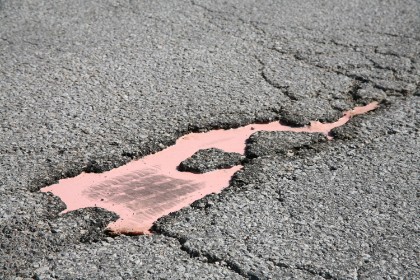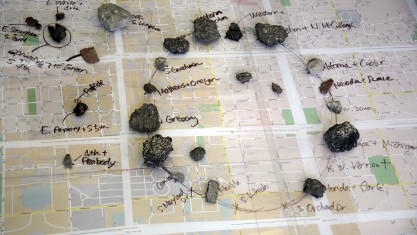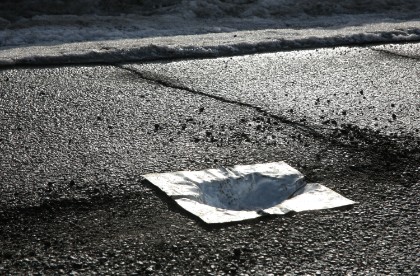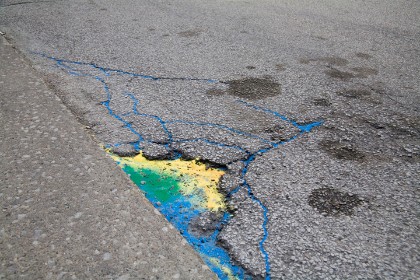interview with Motoko Furuhashi Yun: Let’s talk about your past work, "Road Trip to Mt. Fuji" (2009) first. I thought it will be great to show the piece along with your new necklace piece since I believe these two pieces show how your personal memory is clearly reflected in your work. I think this is different from other artists. It seems to be beyond a methodology for art-making in terms of the distance that you have with your work. Sometimes I feel awkward talking about sincerity in art, but I can’t escape this question when I “come through” your work. I cannot say your work is “inviting,” since I feel it leads inside your brain to share very specific things. This character is also shown in the calligraphy installation work, titled “between 3 to 6”. It was very successful in terms of grabbing the senses of others and bringing them into your world, but also at the same time, it was difficult to critique as an art work in terms of the very strong intimacy between you and the work. Both works are a record of your physical memory though journey, like a scar. Can I ask you to talk more about the process in the calligraphy work and Mt. Fuji?
Motoko: My fascination with the road is an attempt to reconnect memories, understand purpose, and open my mind to going in directions I never before experienced. The work titled “Road Trip to Mt. Fuji” is a map of the journeys to the summit of Mt. Fuji. Looking at the physical map and committing each map to memory allows for travel in any direction. The memory of the map is connected with the experiences along the road. | Chicago street, photo by Yun Jeong Hong, 2009 |
Chicago street, photo by Yun Jeong Hong, 2009 |  Untitled, polyurethane, 2010, on site, photo by Motoko Furuhashi Motoko:Fuji-san is a special place for Japanese people. It is not simply a place that one visits, but a monument that symbolizes the core of Japanese existence. It is a symbol of life and it is the tie that binds many Japanese to their island nation. This philosophical mentality has deep roots in Japanese culture. Having traveled the road to Mt. Fuji several times, each trip was a remarkable experience etching the pathway deep in my memory. Using wire and tracing the map enabled me to revisit these memories and reconnect with moments spent at the summit. |
Motoko:The work titled “between 3 to 6” is a piece about my lost memory after a serious bicycle accident. I have only a vague snapshot of the 12 hours following the event. The road, that once provided so many memories, took them away. Like potholes, my head injury was a visible gap of missing memory along a road traveled. This gap in memory interests me. In an attempt to rebuild my memory, I have returned to the site and listened to a recording of my husband recounting the events in explicit detail. Thinking about the absence of these events in my memory allowed me to realize a connection between memory loss and events on a road as time passes. Calligraphy is a technique that I used often in my past. Using that technique implies the way to connect to my lost memory, as I connect to my past. Yun: Ornament (2011) was different than previous projects since you have different types of distance with your work. I might say it was “colder” than before, but your desire is much clearer to understand. From your past projects, I received the impression of post-minimal gesture in terms of the aesthetic language. | Road Trip to Mt. Fuji,(2009) photo by Yun Jeong Hong |
 Ornament (work in progress), google maps, piece of road from the each location, 2011 | But when you said the silicon that you are using into the potholes is similar to a Band-Aid, I thought about the ecological life of object and society. Could you explain more about your views on the city, roads, and damaged things?
Motoko: I think of those pink urethane pieces as “scabs”. The object was removed from the site, so that pink scab is left with me, but the road pothole will be filled with new asphalt. I think it is the nature of a life. Something we cannot control. Instead of hating the damage and constantly repairing it, I try to appreciate the decay. |
Yun: Then the “scab”
is a memorial object of a specific event?
What does that mean, trying to appreciate the decay? Motoko: Yun: Does it mean
that you are considering the limited life of living things? Are you expecting
to heal the things through your gestures, or it is about recording? How do you
perceive your job as an artist? Motoko: Yun: As an artist who is observing the decaying process of things, it seems that the experience of your understanding of the time flow or the life cycle of things will be different than, for example, the experiences of those who are working on the road. For example, I imagine that a huge tree can live for over three hundred years, and so the tree might feel that a human's life is too short, or it might not even feel the human existence. |  Untitled, hammer sank pewter, 2011, Photo by Motoko Furuhashi |
I am reminded of Treebeard in The Lord of the Rings, who held a different understanding of memory, death, and life because of the slow speed at which he lived. Plants, animals, humans, and things are living at different speeds. If someone is always thinking about the life of the earth or the city, that person might possibly feel the "very slow time flow" of city or earth life. If you consider the city and the road as living things, how do you feel their speed or your speed? What do you think about this idea of a "time flow" for things?
Motoko:
Yun: Do you see yourself as watching or being involved in the life cycle of things? If so, how?
Motoko:
Yun: Also, you went to Japan to see what happened after the tsunami. Do you think visiting there to see the situation affected your working attitude?
 Road crack on N. Broadway Ave. Urbana, Illinois, sand, 2010, detail | Artist Statement I am deeply fascinated with imperfection and the complexity of the natural cycle of growth, decay, and death as the processes that govern life. The overall intent with my work has been to slow the viewer down and make what goes unnoticed important. By highlighting what is viewed as imperfect my work can bring relevance to the object. My belief is that objects only gain importance when the artist draws attention to them. My current work highlights the stress between the geometry of manmade objects and damages created through urban decay. Each obstruction is an unwelcome presence that is disruptive to the ecology of an artificial environment. In challenging the perfectionist ideals that urban environments represent; my use of site-specific art as a medium expands the conceptual meaning and purpose of the object, giving me the freedom to play with the audience’s perception of time and location. This operates on the premise that objects do not exist without perception. Leaving the viewer subjected to my use of the site as a narrative for authenticity and significance. Furthermore, the use of site relevant objects outside of their initial placement leaves room for interpretation allowing the viewer draw conclusions as to the objects worth. This is characterized by my selection of “insignificant” objects as the focal point. Relevant to the site from which it has been excavated, each found object is a unique representation of the interrelationships between time, location, perception, and importance. The aesthetical elements in my work associated with the sequential phases of urban decay are supported using various forms of degradation as visual points of emphasis. These blemishes are a map of events that have taken place long before they were ever noticed. Each imperfection represents its own story and its own reality. None of these are identical; each one is unique to its self and carries a history of distant memories waiting to be told. Because of the way the elements impede urban idealism, the story behind this decay is an indication of how perception is too automatic in respect to what is considered imperfect. The narratives behind these imperfections are what I strive for. I want to draw the audience’s attention to them, highlight what once was unnoticed and tell the stories as they were revealed to me. My work is a shift in the meaning ofperfection transforming our perception of reality to new perspectives. |